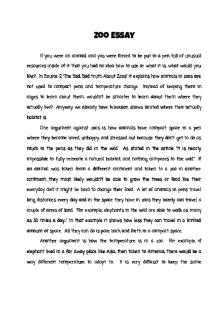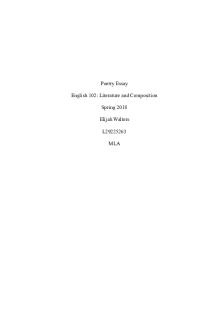Essay \"Research topic was obesity. \" - grade B+ PDF

| Title | Essay \"Research topic was obesity. \" - grade B+ |
|---|---|
| Course | Introduction to Human Health (I) |
| Institution | Athabasca University |
| Pages | 8 |
| File Size | 121.9 KB |
| File Type | |
| Total Downloads | 38 |
| Total Views | 130 |
Summary
Research topic was Obesity. ...
Description
RUNNING HEAD: OBESITY IN CANADA
OBESITY IN CANADA
Health Studies 200
OBESITY IN CANADA OBESITY IN CANADA World health organization (WHO) defines obesity as “ an abnormal or excessive fat accumulation that may impair health.” Obesity is becoming a global epidemic and according to Canadian obesity network 1 among 4 Canadian adults and 1 in 10 children in Canada are obese. Prevalence is higher in women than men and the numbers are tremendously increasing each year, as this becomes a worldwide issue. Obesity can be caused due to multiple factors that include genetics, behaviour, habitat, and much more. There are 66% chances of inheriting obesity genetically, which affects the transmitters and receptors of the hypothalamus and gastro intestinal tract. This can also be the consequence of inutero conditions, which is also termed as genetic imprinting. (A. Youdim, 2015). Environmental factors that are responsible for obesity range from a wide variety of choices an individual makes and also depends on the use of machine. A sedentary lifestyle with reduced physical activity due to increased use of technological aides to make life easier like television, computer and other hi-tech device utilize the time that is to be spent for physical activity. (Hales and Lauzon, 2015) There are variety of endorsements of easy and tasty food that are high in calorie, which is eye catching and tempting. Large portions served at popular food joints tempt people to consume more food due to good taste or the thought of wasting food that results in over eating and ingesting more than required calories. According to a recent study by Tufts University suggests that a most of the single meal without drinks, dessert or appetizer accounts for nearly 1500 calories which makes it hard to eat healthy while eating at restaurants.(C. Carmen, 2016) The out growing fast food culture and increased fast food consumption is one of the leading causes of obesity and associated health problems. Hormones like insulin and stress hormones also lead appetite into temptation, which can result in over eating regardless of feeling full. (Hales and Lauzon, 2015). There is variety of drinks available in market like energy drinks, carbonated soft drinks, alcohol, flavoured water and fruit juices, which contain high amount of sugar and carbohydrates. All these factors promote increase in body weight. (A. Youdim, 2015)
2
RUNNING HEAD: OBESITY IN CANADA Obesity can also be associated with eating disorders like binge eating, night eating and such. This is usually observed in 1- 3% of population, affected equally in men and women and mostly seen in people undergoing weight loss programs and mental illness. Night eating syndrome involves lack of appetite in the morning and hyperphagia (overeating) with lack of sleep at night leading to consumption of 25-50% of the total daily intake after dinner. (A. Youdim, 2015). According to the National Institutes of Health (NIH) some medications used to treat mental illness, seizures etc. can result in weight gain. Cessation of smoking and lack of sleep can also increase the risk for obesity. Obesity can lead to a large number of serious complications like metabolic syndrome, diabetes mellitus, cardiovascular disorders, liver disease, gallbladder disease, gastro esophageal reflux, obstructive apnea, reproductive disorder like infertility. According to CBC news health, BMI of 30 or higher is considered as obese and is associated with above mentioned health risk, which annually costs between $4.6 and $7.1 billion in Canada. Obesity not only has an impact on health and wellbeing of an individual but may also become distress of the abilities at work. A new study conducted by Virginia tech and university of buffalo claims that the workers who are obese are less efficient, often getting injured, longing to take longer breaks as compared to normal weight coworkers (B. Lecia, 2014) There is a lot of social bias and social stigma associated with obesity and people who are overweight. Obese or overweight people are often vulnerable to the negative comments and also have low self-esteem. The most common tools to measure obesity are assessing body mass index (BMI), waist to hip ratio, and waist circumference. Body mass index is the ratio of body weight to the height of an individual. Health care professionals and statisticians use the self-reported information to classify the individual in the classification set by Health Canada, which classifies the BMI into different classes of underweight, normal weight, over weight and obese. The BMI should be calculated of an individual above 18 years of age and cannot be used for children, pregnant and nursing women and elderly. (Hales and Lauzon, 2015)
OBESITY IN CANADA The article chosen to critique in this assignment is “Canada's obesity rates triple in less than 30 years” an article from CBC news .The article draws attention of the readers with the obesity rates specified in the heading. The article’s main focus is about a study conducted by Memorial University that analyzed national and provincial data and came to a conclusion that the 21 percent of Canadian adults will be obese by 2019. The researcher and team disclosed that the health survey collects information on height and weight self reported by the individuals. Hence, Canadian’s BMI are likely an underestimation as self reported numbers could be under reported. To check the credibility of the study, another article from statcan.gc.ca supports the given information. (M. Shields, S.C. Gorber, I. Janssen and M S. Tremblay) The article does not mention basic information about BMI or how to measure BMI. The chapter “Healthy eating for weight management” from the “Invitation to health” by Hales and Lauzon talks about basic information about BMI, Obesity and also other tools of measuring obesity which is not mentioned in this article. The textbook also has BMI classification and ranges of BMI from underweight to obese class III whereas in the article underweight category is not mentioned and is more focused on the obese class 2 and class 3. The article is solely based on statistic from the study and has no author based opinion or voice. The use of high diction and statistical report from the study and makes the article a good summary of the study but can be easy to gain information about the provincial obesity rates. The article also talks about the risk factors that are linked to obesity and the cost associated with it which can get the readers thinking about the cost effect and health risks of being obese. The use of BMI to measure obesity is questionable as it is not appropriate to every body type specially because muscle weight is heavier than fat therefore putting a
4
RUNNING HEAD: OBESITY IN CANADA muscular athletes in the obese category which is also mentioned in the textbook. The article provides a conclusion of the study and states the preventive measures assigned by provinces to address and treat the rising rates of obesity. The article has a few strengths and limitations that do not interfere with the articles ability to educate on the given topic. One of the few main strengths of the article is even though it uses high diction words and statistical reports; it still manages to convey the summary of the study in an easy and effortless way and also understandable to the general population. There is a lot of further research that can be done on the topic, which would be recommended. One of the main topics recommended to research on is the use of BMI to measure obesity, as it could be a controversial. The American Journal of Clinical nutrition published a study, which suggest that body-fat percentage may be a better measure of your risk of weight-related diseases than BMI. (Casey John) Also including other types of tools used to measure obesity would give the readers an idea about the recourses available to compare and decide for themselves. The other strength of the article is providing a conclusion of the study, which also mentions how they are planning to measure the approaches used to prevent and treat obesity. Being a news article, the article doesn’t have an opinionated voice or doesn’t have author’s thoughts rather just a summary of the article. The other limitation for this article is missing basic information about BMI, which can cause some readers to loose interest. The assertion by the researcher and team about Canadian’s BMI being underestimated due to self reported heights and weights and later in an article using BMI to categorise obesity and drawing conclusion can be contradicting.
OBESITY IN CANADA The article provides accurate information for the reader to trigger their thought for exploring more about increasing obesity rates. As from a reader’s point of view, there is further research to be done about the topic and also include other obesity measuring tools for the readers to refer. The increasing rate of obesity around the world is a leading cause of other health diseases that needs a prevention and treatment plan. Measuring obesity not just using one tool rather using other assessing tools like waist to hip ratio, waist circumference and assessing body-fat percentage using tools like skin fold measurement, bioelectrical impedance analysis, dual-energy X-ray absorptiometry (DXA), hydrostatic (underwater) weighing and air displacement plethysmography could provide better reliable results. (Hales and Lauzon, 2015) Obesity is a blooming health concern, which includes many other chronic health conditions. As the rate of obesity increases the awareness among public and health education are positive implementation where as body shamming and discrimination have a negative influence on the individuals performance. The article critiqued in the paper can help people to be mindful of the obesity rates and can also encourage people to maintain healthy weight. This article also highlights local and provincial programs, which might interest the readers to look for local resources available to stay active. Thus the issue of obesity in Canada is a subject that puts the country’s health care, economy and manpower at risk.
6
RUNNING HEAD: OBESITY IN CANADA
References B. Lecia, Obesity In The Workplace: Overweight Employees Are Less Productive, Need Longer Breaks To Rest, Healthy living, 2014, Retrieved from http://www.medicaldaily.com/obesity-workplace-overweight-employees-are-lessproductive-need-longer-breaks-rest-295160 C. Carmen, Follow this one tip if you’re trying to loose weight, Study suggest suggests, retrieved from http://globalnews.ca/news/2475323/follow-this-one-tip-if-youretrying-to-lose-weight-study-suggests/ Casey, J. Body Fat Measurement: Percentage Vs. Body Mass. Retrieved from http://www.webmd.com/diet/body-fat-measurement Hales, D., & Lauzon, L. (2015). Healthy Eating for Weight Management. In An invitation to health (4th Canadian ed., pp. 131- 149). Toronto: Nelson Education. News, C. (2014, March 04). Canada's obesity rates triple in less than 30 years. Retrieved from http://www.cbc.ca/news/health/canada-s-obesity-rates-triple-in-less-than30-years-1.2558365 Obesity in Canada. (n.d.). Retrieved from http://www.obesitynetwork.ca/obesityin-canada Shields, M., Gorber, S., Janssen, I., & Tremblay, M. (n.d.). Bias in self-reported estimates of obesity in Canadian health surveys: An update on correction equations for adults. Retrieved July 1, 2015, from http://www.statcan.gc.ca/pub/82-003x/2011003/article/11533-eng.htm
OBESITY IN CANADA What Are Overweight and Obesity? (2012, July). National Institutes of Health. Retrieved from http://www.nhlbi.nih.gov/health/health-topics/topics/obe Youdim, A. (2014, February 14). Obesity - Nutritional Disorders. Retrieved from http://www.merckmanuals.com/professional/nutritional-disorders/obesity-and-themetabolic-syndrome/obesity
8...
Similar Free PDFs

Rogerian Essay - Grade: B
- 2 Pages

Zoo Essay - Grade: B+
- 2 Pages

Causation Essay - Grade: B
- 4 Pages

Final Essay - Grade: B+
- 12 Pages

Propaganda Essay - Grade: b
- 4 Pages

Poetry Essay - Grade: B
- 5 Pages

Galileo Essay - Grade: B+
- 6 Pages

Fiction Essay - Grade: B
- 7 Pages

EPQ Essay - Grade: B+
- 10 Pages

Law essay - Grade: B
- 9 Pages

Persuasive Essay - Grade: B
- 3 Pages

Evicted Essay - Grade: B+
- 3 Pages

Charities essay - Grade: B+
- 13 Pages

Reflective Essay - Grade: B
- 4 Pages

Research essay - Grade: A
- 5 Pages
Popular Institutions
- Tinajero National High School - Annex
- Politeknik Caltex Riau
- Yokohama City University
- SGT University
- University of Al-Qadisiyah
- Divine Word College of Vigan
- Techniek College Rotterdam
- Universidade de Santiago
- Universiti Teknologi MARA Cawangan Johor Kampus Pasir Gudang
- Poltekkes Kemenkes Yogyakarta
- Baguio City National High School
- Colegio san marcos
- preparatoria uno
- Centro de Bachillerato Tecnológico Industrial y de Servicios No. 107
- Dalian Maritime University
- Quang Trung Secondary School
- Colegio Tecnológico en Informática
- Corporación Regional de Educación Superior
- Grupo CEDVA
- Dar Al Uloom University
- Centro de Estudios Preuniversitarios de la Universidad Nacional de Ingeniería
- 上智大学
- Aakash International School, Nuna Majara
- San Felipe Neri Catholic School
- Kang Chiao International School - New Taipei City
- Misamis Occidental National High School
- Institución Educativa Escuela Normal Juan Ladrilleros
- Kolehiyo ng Pantukan
- Batanes State College
- Instituto Continental
- Sekolah Menengah Kejuruan Kesehatan Kaltara (Tarakan)
- Colegio de La Inmaculada Concepcion - Cebu
